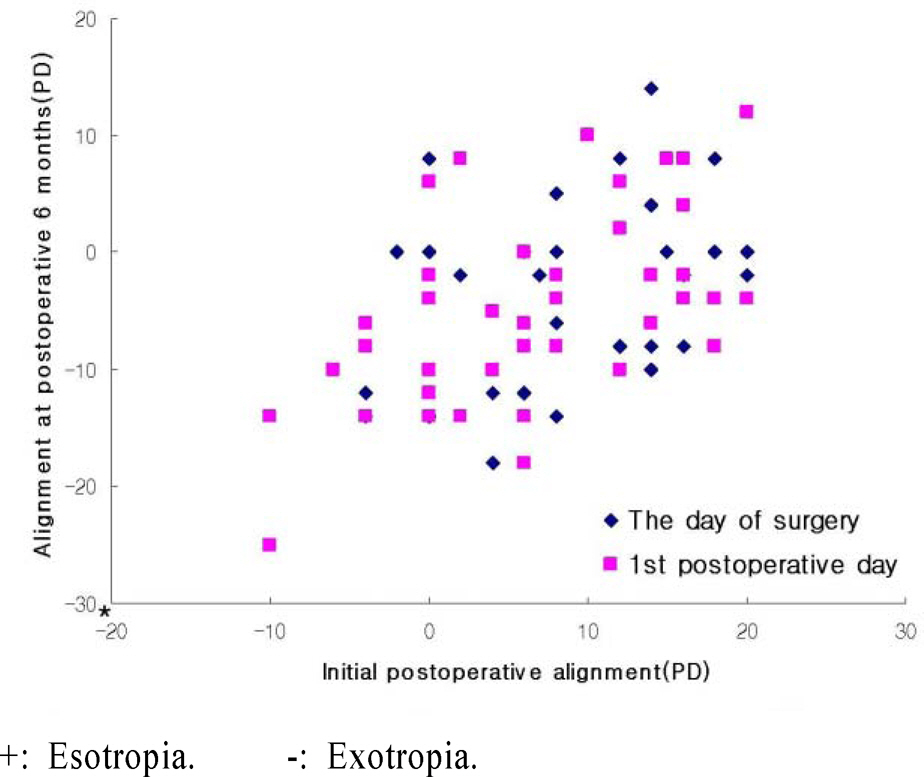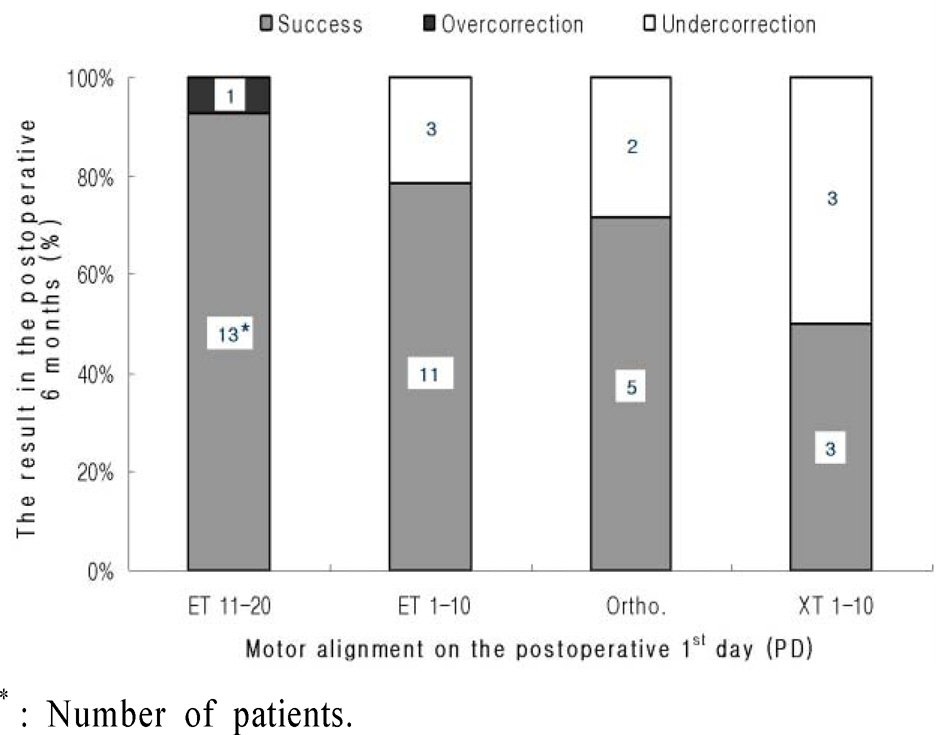J Korean Ophthalmol Soc.
2007 Aug;48(8):1106-1111.
Relationship Between Surgical Result and Alignment on The Day of Surgery in Intermittent Exotropia
- Affiliations
-
- 1Department of Ophthalmology, College of Medicine, Pusan National University, Pusan, Korea. hychoi@pusan.ac.kr
- 2Okpo Soungmo Eye Clinic, Geoje, Korea.
Abstract
-
PURPOSE: We assessed the relationship between the surgical outcome of intermittent exotropia and initial postoperative alignment by checking it on the first postoperative day or the day of strabismus surgery.
METHODS
Seventy-three patients with intermittent exotropia underwent bilateral lateral rectus recession or unilateral medial rectus resection and lateral rectus recession. Thirty-two patients had their postoperative alignment checked on the day of surgery, and forty-one patients were checked on the first postoperative day. Success was defined as sustained alignment six months postoperatively from esotropia 10PD to exotropia 10PD. Overcorrection was defined as esotropia greater than 11PD, and undercorrection was exotropia greater than 11PD. We assessed the relationship between the alignment on the day of surgery or on the first postoperative day and also at six months postoperatively, as well as the success rate according to the initial postoperative alignment.
RESULTS
There was a statistically significant relationship between alignments on the day of surgery or on the first postoperative day and those at six months postoperatively (p<0.001, p<0.001). The deviation on the first postoperative day had a greater correlation coefficient compared to the deviation on the day of the operation (Pearson correlation coefficient=0.704, and 0.593, respectively). The alignment of overcorrection ranged from 11~20PD on the day of surgery, and on the first postoperative day it produced a relatively high success rate (p=0.016, p=0.035). There was no statistically significant difference in the success rate between the two types of surgery (p=0.832).
CONCLUSIONS
The alignment on the day of surgery showed a high correlation to the outcome on the sixth postoperative month in intermittent exotropia patients. The initial postoperative overcorrection of 11 to 20PD on the day of surgery and on the first postoperative day resulted in the best long-term outcomes.
MeSH Terms
Figure
Reference
-
References
1. Rah SH, Jun HS, Kim SH. An epidemiologic survey of strabismus among school - children in Korea. J Korean Ophthalmol Soc. 1997; 38:2195–9.2. Duane A. A new classification of the motor abnormalies based upon physiological principles together with their symptoms, diagnosis, and treatment. Am Ophthamol Otolaryngol. 1897; 6:84–122.3. Bielschowsky A. Divergence excess. Arch ophthalmol. 1934; 12:157–66.
Article4. Burian HM, Spivey BE. The surgical management of exodeviations. Am J Ophthalmol. 1965; 59:603–20.5. Hardesty HH, Boynton JR, Keenan JP. Treatment of intermittent exotropia. Arch Ophthalmol. 1978; 96:268–74.
Article6. Pratt-Johnson JA, Barlow JM, Tillson G. Early surgery in intermittent exotropia. Am J Ophthalmol. 1977; 84:689–94.
Article7. Raab EL, Parks MM. Recession of lateral recti. Arch Ophthalmol. 1969; 82:203–8.8. Richard JM, Parks MM. Intermittent exotropia-surgical results in different age groups. Ophthalmology. 1983; 90:1172–7.9. Lee SY, Lee YC. Comparison of surgical results by initial postoperative alignment following bilateral lateral rectus recession and unilateral lateral rectus recession-medial rectus resection in intermittent exotropes. J Korean Ophthalmol Soc. 1999; 40:2604–10.10. Gezer A, Sezen F, Nasri N, Gozum N. Factors influencing the outcome of strabismus surgery in patients with exotropia. J AAPOS. 2004; 8:56–60.
Article11. Ruttum MS. Initial versus subsequent postoperative motor alignment in intermittent exotropia. J AAPOS. 1997; 1:88–91.
Article12. Stroller SH, Simon JW, Lininger LL. Bilateral lateral rectus recession for exotropia: A survival analysis. J Pediatr Ophthalmol Strabismus. 1997; 34:217–22.
Article13. Ko KH, Min BM. Factors related to surgical results of intermittent exotropia. J Korean Ophthalmol Soc. 1996; 37:179–84.14. Choi DG, Kim PS. The surgical outcome of intermittent exotropia and the prognostic factors. J Korean Ophthalmol Soc. 1998; 39:207–15.15. Scott WE, Keech R, Mash AJ. The postoperative results and stability of exodeviations. Arch Ophthalmol. 1981; 99:1814–8.
Article16. Stoller SH, Simon JW, Lininger LL. Bilateral lateral rectus recession for exotropia: a survival analysis. J Pediatr Ophthalmol Strabismus. 1994; 31:89–92.
Article17. Kim YR. Anesthesia. 1st ed.1. Seoul: Koonja publishing;2002. p. 623.18. Souza-Dias C, Uesugui CF. Postoperative evolution of the planned initial overcorrection in intermittent exotropia: 61 cases. Binocul Vis Strabismus Q. 1993; 8:141–8.19. von Noorden GK. Binocular vision and ocular motility. St Louis: The C.V. Mosby Co.;1994. p. 438–42.20. Kim SJ. Comparisons of surgical results between bilateral recession and unilateral recession-resection in intermittent exotropia. J Korean Ophthalmol Soc. 1990; 31:1594–9.
- Full Text Links
- Actions
-
Cited
- CITED
-
- Close
- Share
- Similar articles
-
- Comparison of Surgical Results by Initial Postoperative Alignment Following Bilateral Lateral Rectus Recession and Unilateral Lateral Rectus Recession-Medial Rectus Resection in Intermittent Exotropes
- Surgical Results of Intermittent Exotropia
- The Surgical Outcome of Intermittent Exotropia and the Prognostic Factors
- The Relationship between Binocular Function and the Surgical Outcome of Intermittent Exotropia
- Clinical Study on Factors Associated with Recurrence and Reoperation in Intermittent Exotropia




